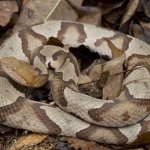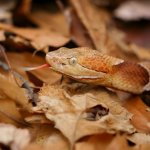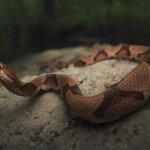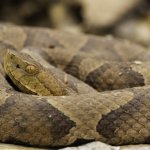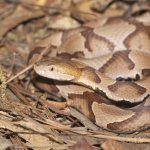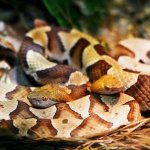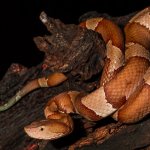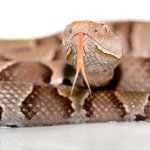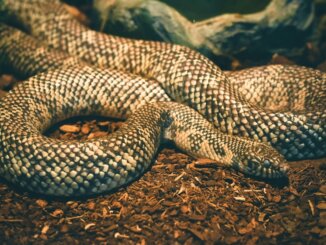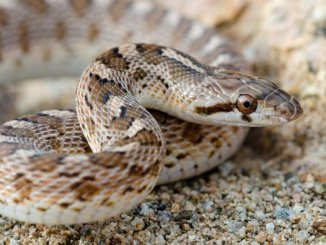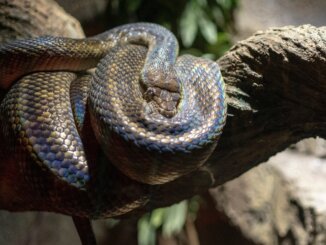The Copperhead snake is a member of the pit viper family.
They are easily identifiable by their hourglass-shaped markings and reddish heads.
This snake is native to eastern America and northern Mexico so they can thrive in many different ecosystems: forests, prairies, canyons, and rocky waterways.
Although this snake has a venomous bite, they make an excellent pet for those with prior experience and are relatively easy to care for in captivity.
If you are looking for a non-traditional snake, with a unique pattern and docile nature, then check out our guide sheet below to learn how to care for this species…
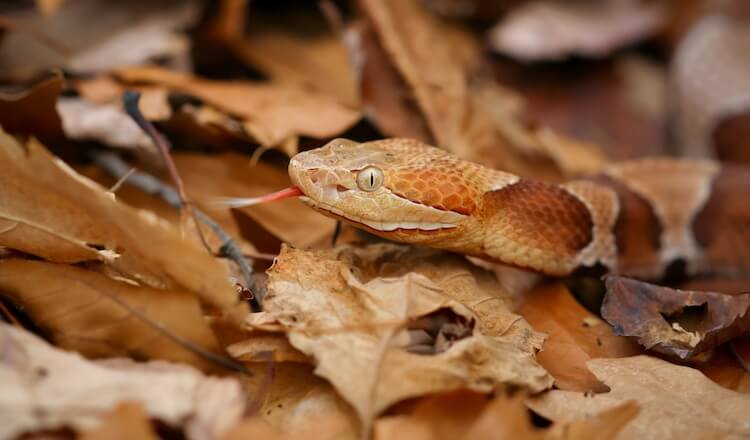
Copperhead Snake Overview
The Copperhead was first identified by Carl Linnaeus (one of the most renkown biologists) in 1766.
Since their discovery, owners have loved this species because of their unconventional markings and venomous nature.
Although a Copperhead’s bite is venomous, it is rarely fatal to humans because their venom is classified as mild. For this reason, many experienced owners look to purchase this species as their first venomous snake.
They are not the best pet for first time snake owners.
Owners must be confident in their handling abilities before adding them to their household.
Besides their unpredictable behavior of striking without warning, this snake is relatively easy to care for in captivity, they have:
- Relatively low temperature requirements.
- No specific humidity requirements.
- Thrive in a variety of habitats.
- Only require a meal once every two weeks.
Once owners feel comfortable handling snakes, this species can make an excellent pet because they are not high maintenance.
Where are Copperheads most commonly found?
Originating from North America, the Copperhead is found anywhere from northern U.S. states such as Connecticut all the way to the Mexican providences of Coahuila and Chihuahua.
They are found living in a wide variety of habitats, but typically prefer to be close to a water source (e.g. river or stream).
What We Like About This Species
Pros
- Low husbandry requirements and only need feeding once every two weeks.
- Long life span of up to 25 years in captivity.
- They are a sociable species and can occasionally be found living in clusters.
- Hardy snake with an ability to thrive in a variety of enclosure types.
- Young copperheads use their distinct yellow tail to bait prey into coming close enough to catch.
Cons
- Unpredictable behavior and give very little warning before striking.
- They can have a pretty nasty venomous bite.
- They account for more venomous snakebites in the United States than any other snake species.
How To Identify A Copperhead Snake
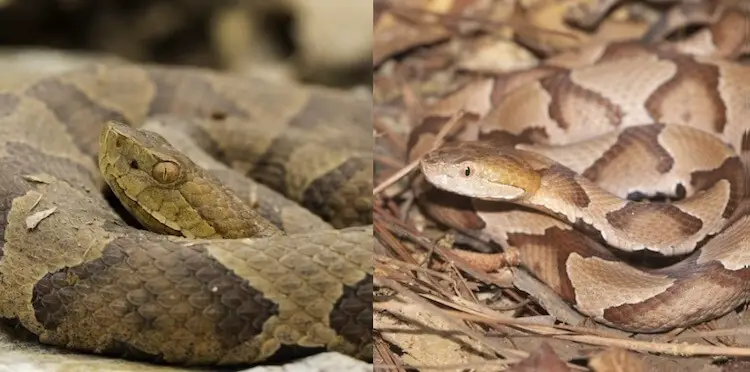
They are easily identifiable because of their large red head and irregularly cross-banded body.
This snake is named after their broad red, or copper, head and their pattern is unlike any other species. It consists of a predominantly tan color with pinkish brown hourglass bands.
There are five subspecies that are all associated with slightly different colorations and regional distributions:
- Northern copperhead (Agkistrodon contortrix mokasen)
- Southern copperhead (A.c. contortrix)
- Osage (A.c. phaeogaster)
- Broad-banded (A.c. laticinctus)
- Trans-Pecos (A.c. pictigaster)
Of these, the southern species is most abundant in the United States.
In the wild, rat snakes are commonly mistaken for this species, but this snake has wider and denser bodies.
Copperhead Size
Babies are between 8 and 10 inches. Adults normally reach two to three feet after three years. The largest can reach sizes of up to four feet in length.
Males are normally smaller than females; however, males typically have longer tails. Juveniles have a strikingly bright yellow tail, which unfortunately fades after thee or four years.
Most babies weigh less than an ounce when born and grow to approximately half a pound at adulthood. On the smaller end of the pit viper family, other snakes such as rattlesnakes are typically much larger.
Color Variations and Markings
There are several different distinct color variations in this species.
Each of the five subspecies has slightly different colorations and patterns.
Northern Copperheads have a darker brown appearance, while the southern species having a much lighter tan body.
Their hourglass band normally runs horizontally but sometimes they can have a striped coloration with bands appearing vertically.
Copperhead Snake Care
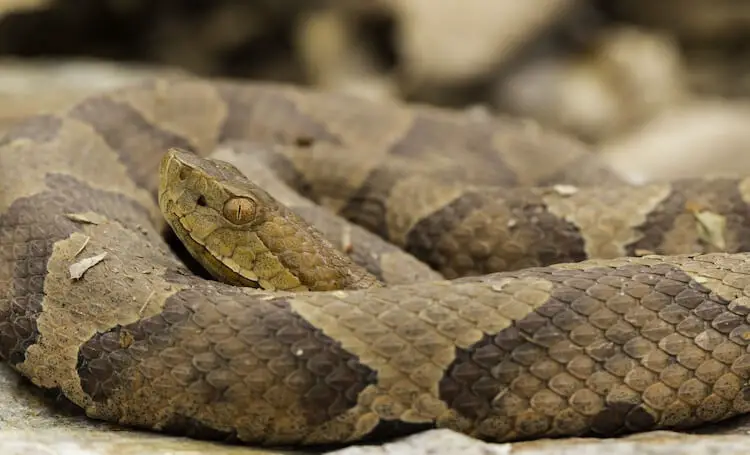
Copperhead Diet
This snake is carnivorous. They eat lots of small prey including: mice, lizards, frogs, and birds.
In the wild, they have been documented to eat as little as 10 to 12 times each year. In captivity, they generally eat once every two weeks.
A Copperhead will kill their prey by striking it and injecting venom into it. After injecting the venom they hold the prey in their jaw until it dies before swallowing it whole.
In captivity, this pet will thrive on a diet of thawed mice.
Live prey should be avoided as they can bite and injure the snake.
Juveniles can be fed smaller rodents such as pinkies.
They are known to have a voracious appetite, so using long forceps to introduce thawed mice into their enclosure is the only way to avoid being bitten.
If your pet doesn’t consume the mouse within a few hours then it should be removed from the enclosure. Fruits and vegetables should never be included in their diet.
Finally, a copperhead should be provided with a water dish that is large enough for both drinking and soaking. This dish should be changed daily and thoroughly cleaned weekly to prevent bacteria from growing in it.
Lifespan & Health
Like all snakes kept as pets there are several common health issues that can occur if incorrect husbandry is followed or enclosures are not properly maintained. Mouth rot, parasites, and dermatitis are common in this species:
- Mouth rot, also known as Infectious stomatitis, is a common problem with snakes kept in captivity. Normally due to a mouth injury, improper diet, or unsanitary environment this illness results in bloody gums.
- Parasitic infections are also common and can be due to a variety of organisms including worms, coccidia, ticks, lice, and protozoa. Parasitic infections will require treatment with dewormers.
- Inflammation and infection of the skin leading to improper shedding is also a common health problem. Typically, this is a result of enclosures that are too moist and must be treated with topical solutions.
Compared to many other species, the copperhead has a relatively long life span. They are known to live in the wild for up to 18 years and 25 years in captivity.
Signs They Are Healthy
- Bright and alert eyes.
- Healthy appetite.
- Quiet and effortless breathing.
- Smooth/shiny scales.
Sickness Symptoms
- Stargazing.
- Weight loss.
- Mouth breathing.
- Issues with shedding skin.
Copperhead Enclosure
This snake can be found living in many different environments ranging from dense forests to open fields, but they prefer living near waterways in woodlands.
During the day, they enjoy sunbathing on rocky structures along rivers and streams, and at night will retreat to the protection of logs.
They are a hardy snake and adapt well to new environments.
The main points to consider when setting up an enclosure for a copperhead are that a designated basking spot is essential and numerous hiding spots should be included.
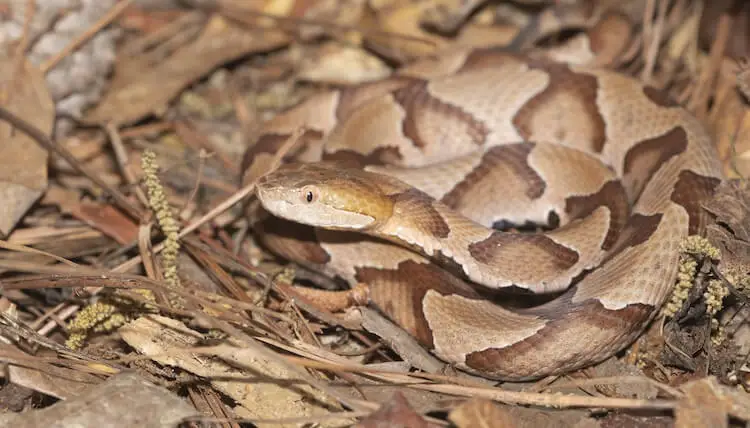
Because this snake requires an enclosure temperature much lower than most pet reptiles, the type of terrarium used to house them isn’t extremely important.
A larger sized glass or wooden terrarium works well.
Make sure their terrarium is at least 30-gallons, and if you are housing in pairs then 50-gallons is recommended.
There are four necessary additions to a copperhead’s enclosure which will allow them to express their natural behaviors:
- Hiding places such as logs and boxes should be included for them to retreat to when intimidated.
- A basking spot (ideally a designated rock) should be included as basking is how most copperheads normally spend their day.
- A water dish large enough to allow soaking should be included and changed daily.
- It is very important to have a secure lid attached to the terrarium as they are known to escape.
As their enclosure should remain less than 85 degrees, a basking lamp aimed at a single basking rock is the best heat source (do not use heat rocks; they are damaging).
A mercury vapor bulb is the best choice for the basking lamp.
The basking spot should reach a temperature between 92 and 95 degrees.
At night, the basking lamp should be turned off, and the enclosure should be between 67 and 70 degrees.
Copperheads are cold-blooded organisms and use their environment to control their body temperature. Having a hot basking spot and a cooler side of the tank is crucial for their thermo-regulation.
- Tank Type: wooden or glass vivarium.
- Tank Size: 30 to 50 gallons.
- Lighting: mercury vapor bulb.
- Substrate: dried oak.
As a burrowing snake, they do best on a substrate in which they can immerse themselves and burrow. Ideally, fallen oak and maple leaves are the best choices as it mimics their natural environment. Other substrate options include Cyprus shavings or pelleted newspaper.
Cleaning & Misting
Correct and routine cage cleaning is a must to keep this snake healthy.
Water should be changed daily, and food should be removed if not consumed.
Substrate should be removed and changed weekly and the entire terrarium should be washed with non-toxic soap and hot water on a monthly basis.
Feces should be spot cleaned and inspected for undigested food parts. Snake feces should be firm with a darker, blackish section and lighter, white section. If blood or undigested food parts are found in the feces, then your snake is sick.
Typical Behavior
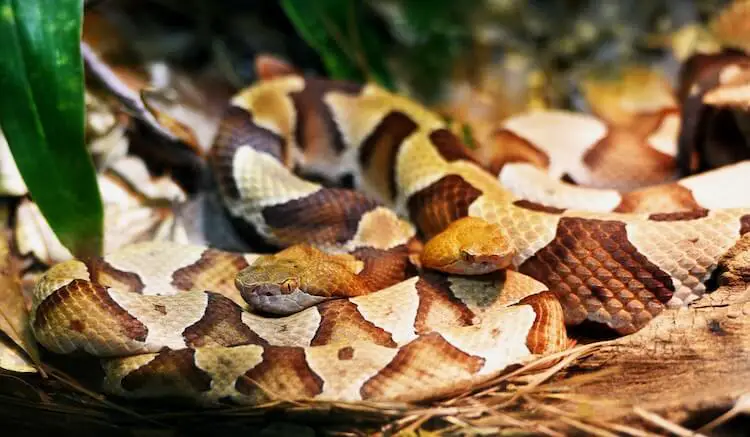
Their behavior in the wild includes basking during the day, hiding at night, and occasionally swimming and hunting.
Like most pit vipers, they use camouflage to blend into their environment and wait for prey to come near. They use a facial pit between their eyes to detect the movement of warm-blooded organisms (even in complete darkness).
This snakes’ main form of communication is through the release of pheromones. Pheromones are specific chemicals that can be picked up by another snake’s vomeronasal organ.
A copperhead will also use visual and tactile communication tactics when mating, including neck flexion, posterior trunk contraction, hovering, swaying, and topping behaviors.
This species has aggressive mating behaviors:
- Males can be aggressive towards other males as fighting is common to determine which snake gets to mate with the female.
- Females will sometimes attack males when approached for mating, forcing the male prove his dominance.
Copperheads are a sociable species and can be found in clusters in the wild.
They aren’t very territorial, and so will form clusters in habitats where prey is readily available. In captivity, they do best if housed individually but can be housed in pairs if introduced to each other at a very young age.
In the winter, this snake will brumate to avoid the cold and scarcity of prey. They will either brumate in individual or communal dens, but will typically return to the same den every winter. In captivity, they will not brumate.
Surprisingly docile, in captivity they will bask or hide most of the day, conserving as much energy as possible.
Are Copperhead Snakes Poisonous?
No. However they are venomous and will strike when nervous or exposed to quick movements. Their venom is currently being researched as a treatment for a variety of medical conditions including cancer, stroke, and diabetes.
How Deadly Is a Copperhead?
Their venom, although toxic enough to kill small prey, is not typically potent enough to kill humans. In the wild, however, they’ll hunt small rodents, birds, lizards, and frogs, and their toxin is enough to kill this prey.
If a human, dog or cat is bitten by this species, medical attention should immediately be sought.
A Copperhead’s venom results in the destruction of red blood cells and prevents oxygen from reaching necessary parts of the body. An antitoxin is available and should be kept by owners in case they are bitten.
Handling Advice and Tips
A Copperhead should only be handled when necessary.
Snake hooks aren’t very effective, due to their dense body type. Clampsticks are the best tool for handling as it allows for adequate control over the snake.
Signs of stress include tail shaking and mouth breathing.
Tail shaking and mouth breathing can indicate that your pet is about to strike.
Although their venom can be dangerous, as long as owners are cautious and controlled when handling and storing these snakes, both the snake’s and the owner’s safety can be greatly improved.
Baby Copperhead

There are two distinct mating seasons during any given year, spring and fall. Mothers immediately abandon their young to survive on their own in the wild.
Copperheads incubate their eggs inside their bodies and give birth to about 2-18 live offspring.
At birth, these snakes are 8 to 10 inches long and weigh about an ounce.
They will start off eating mostly insects before transitioning to mice, frogs, lizards, and birds.
A Baby Copperhead will cost anywhere from $100 to $300 depending on their subspecies, coloration, and age.
This snake is difficult to find because they are only available from select captive breeders.
A thorough physical exam and history should be taken before purchasing. Buyers should examine the snake for signs of health issues such as stargazing, patching scales, or an inflamed mouth. Copperheads and other snakes should be bright and alert of their surroundings.
Copperhead Snake Facts
| Common Name | Copperhead |
|---|---|
| Scientific Name | Agkistrodon contortrix |
| Price | $100 to $300 |
| Size | 2-3 feet long |
| Lifespan | ~25 years |
| Diet | Small rodents |
| Tank Size | 30 to 50 gallons |
| Humidity & Temperature | Daytime temperature: 75℉-85℉ Nighttime temperature: 67℉-70℉ Basking Spot: 92°F-95°F |
| Popular Alternatives | Rattlesnakes and Cottonmouths |
Summary
The copperhead is extremely overlooked by many reptile owners for brighter and more venomous snakes such as rattlesnakes and moccasins.
Despite being unpopular, they are one of the easiest snakes to maintain in captivity and do not have many of the specific requirements of many other reptiles kept in captivity.
A great choice for anyone comfortable handling snakes, and although venomous, their bite is rarely fatal to humans.
If you are looking to add a venomous snake to your collection but are hesitant to purchase some of the larger and more venomous cobras and rattlesnakes, then this species is perfect.
Let us know your thoughts below.

